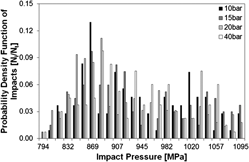Crossref Citations
This article has been cited by the following publications. This list is generated based on data provided by
Crossref.
Franc, Jean-Pierre
Riondet, Michel
Karimi, Ayat
and
Chahine, Georges L.
2011.
Impact Load Measurements in an Erosive Cavitating Flow.
Journal of Fluids Engineering,
Vol. 133,
Issue. 12,
Carnelli, Davide
Karimi, Ayat
and
Franc, Jean-Pierre
2012.
Evaluation of the hydrodynamic pressure of cavitation impacts from stress–strain analysis and geometry of individual pits.
Wear,
Vol. 289,
Issue. ,
p.
104.
Karimi, Ayat
and
Franc, Jean-Pierre
2014.
Advanced Experimental and Numerical Techniques for Cavitation Erosion Prediction.
Vol. 106,
Issue. ,
p.
163.
Stella, Jorge
Pohl, Michael
Bock, Claudia
and
Kunze, Ulrich
2014.
Influence of grain orientation on the local deformation mode induced by cavitation erosion in a CuSnNi alloy.
Wear,
Vol. 316,
Issue. 1-2,
p.
1.
Harvey, Gerald
Gachagan, Anthony
and
Mutasa, Tapiwa
2014.
Review of high-power ultrasound-industrial applications and measurement methods.
IEEE Transactions on Ultrasonics, Ferroelectrics, and Frequency Control,
Vol. 61,
Issue. 3,
p.
481.
Chahine, Georges L.
Franc, Jean-Pierre
and
Karimi, Ayat
2014.
Advanced Experimental and Numerical Techniques for Cavitation Erosion Prediction.
Vol. 106,
Issue. ,
p.
3.
Tzanakis, I.
Eskin, D.G.
Georgoulas, A.
and
Fytanidis, D.K.
2014.
Incubation pit analysis and calculation of the hydrodynamic impact pressure from the implosion of an acoustic cavitation bubble.
Ultrasonics Sonochemistry,
Vol. 21,
Issue. 2,
p.
866.
Roy, Samir Chandra
Franc, Jean-Pierre
and
Fivel, Marc
2015.
Cavitation erosion: Using the target material as a pressure sensor.
Journal of Applied Physics,
Vol. 118,
Issue. 16,
Roy, Samir Chandra
Franc, Jean-Pierre
Pellone, Christian
and
Fivel, Marc
2015.
Determination of cavitation load spectra – Part 1: Static finite element approach.
Wear,
Vol. 344-345,
Issue. ,
p.
110.
Wang, Yong
Zhuang, Suguo
Liu, Houlin
Zhao, Zhenjiang
Dular, Matevž
and
Wang, Jian
2017.
Image post-processed approaches for cavitating flow in orifice plate.
Journal of Mechanical Science and Technology,
Vol. 31,
Issue. 7,
p.
3305.
Sreedhar, B.K.
Albert, S.K.
and
Pandit, A.B.
2017.
Cavitation damage: Theory and measurements – A review.
Wear,
Vol. 372-373,
Issue. ,
p.
177.
Ye, Linzheng
and
Zhu, Xijing
2017.
Analysis of the effect of impact of near-wall acoustic bubble collapse micro-jet on Al 1060.
Ultrasonics Sonochemistry,
Vol. 36,
Issue. ,
p.
507.
Peng, Kewen
Tian, Shouceng
Li, Gensheng
Huang, Zhongwei
and
Zhang, Zhenxiang
2017.
Cavitation in water jet under high ambient pressure conditions.
Experimental Thermal and Fluid Science,
Vol. 89,
Issue. ,
p.
9.
Marcon, Andrea
Melkote, Shreyes N.
and
Yoda, Minami
2018.
Effect of nozzle size scaling in co-flow water cavitation jet peening.
Journal of Manufacturing Processes,
Vol. 31,
Issue. ,
p.
372.
Al-Hashem, Abdulhameed
Abdullah, Abdulmajeed
and
Riad, Wafa
2018.
Cavitation - Selected Issues.
Marcon, Andrea
Melkote, Shreyes N.
Yoda, Minami
and
Sanders, Daniel
2018.
Analysis of Co-Flow Water Cavitation Peening of Al7075-T651 Alloy Using High-Speed Imaging and Surface Pitting Tests.
Materials Performance and Characterization,
Vol. 7,
Issue. 5,
p.
1018.
Peng, Kewen
Tian, Shouceng
Li, Gensheng
and
Alehossein, Habib
2018.
Mapping cavitation impact field in a submerged cavitating jet.
Wear,
Vol. 396-397,
Issue. ,
p.
22.
Wang, Shi-Ping
Zhang, A-Man
Liu, Yun-Long
Zhang, Shuai
and
Cui, Pu
2018.
Bubble dynamics and its applications.
Journal of Hydrodynamics,
Vol. 30,
Issue. 6,
p.
975.
Schreiner, Felix
Paepenmöller, Simon
and
Skoda, Romuald
2020.
3D flow simulations and pressure measurements for the evaluation of cavitation dynamics and flow aggressiveness in ultrasonic erosion devices with varying gap widths.
Ultrasonics Sonochemistry,
Vol. 67,
Issue. ,
p.
105091.
Fang, Liang
Li, Wei
Li, Qiang
and
Wang, Zhenbo
2020.
Numerical investigation of the cavity shedding mechanism in a Venturi reactor.
International Journal of Heat and Mass Transfer,
Vol. 156,
Issue. ,
p.
119835.





